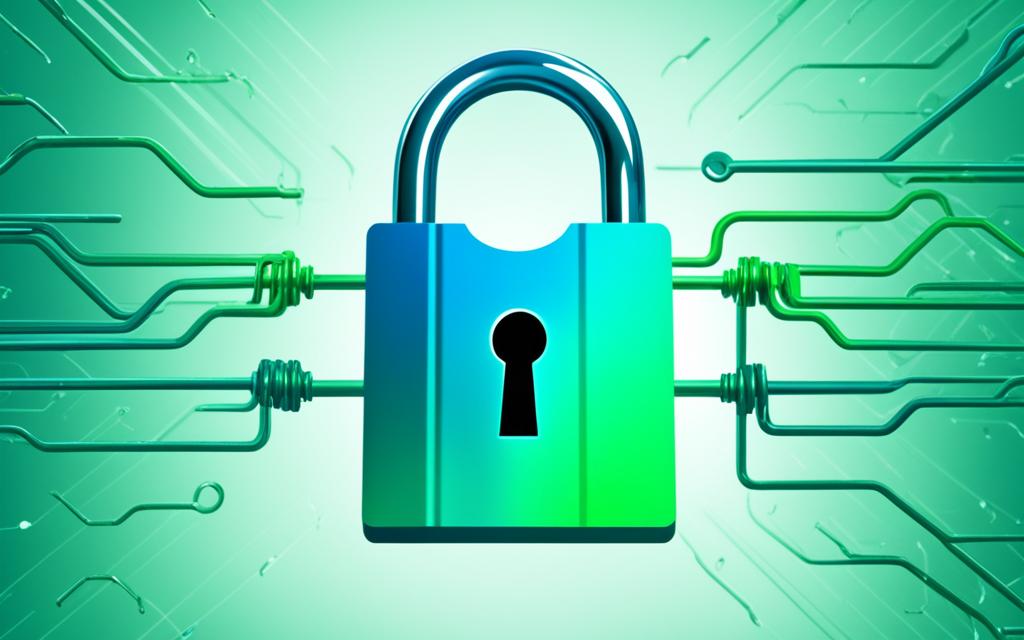How to Enable SSO in FortiClient for macOS VPN Easily
Enabling Single Sign-On (SSO) in FortiClient for macOS VPN makes logging in easier. You only need to enter your credentials once, giving you easy access to the VPN. This is key in today’s world, where secure remote access is crucial. I’ll show you how to set up SSO in FortiClient for macOS, explain why it’s important, and talk about its benefits.
Setting up SSO depends on your needs, and it requires careful configuration. You’ll need to set up your Identity Provider (IdP) and create a Single Sign-On object in FortiClient. These steps are important for a secure VPN connection. Let’s dive into how SSO in FortiClient can make your access more secure1.
Understanding SSO and Its Importance
Single Sign-On (SSO) lets me log into many applications with just one set of login details. This has changed how people use services in many places. The importance of SSO comes from making things easier by cutting down on the number of passwords I have to remember.
SSO also makes things more secure. It helps avoid password fatigue, where people use weak passwords or the same one everywhere because they can’t keep track of many. This lowers a big security risk.
The benefits of Single Sign-On are big for IT teams too. It makes managing users and access easier and faster. For companies using cloud services and working remotely, keeping user access secure is key to making things run smoothly. Many groups are now using SSO to make sure users are properly checked and given access.
Adding SSO brings many strategic benefits, showing how it’s changing how people log in across different fields. But, it’s also important to think about the challenges like making it work with other systems and training users.
Knowing about “what is SSO” and its effects on users and IT teams is crucial for making smart choices about managing access to technology234.
What is FortiClient?
FortiClient is a top-notch security software made by Fortinet. It’s all about giving a solid VPN experience for devices on company networks. It’s key for keeping devices safe when they connect to the company from afar.
FortiClient does more than just VPN. It fights off malware and viruses, giving a full shield for businesses. This is super important in today’s world where working from home is common and risks are high.
Adding FortiClient to a company’s security setup means making sure it helps with safe remote access. It has cool features like Single Sign-On (SSO) that make logging in easier and safer. But, remember, it only works on macOS 11 and up5.
Setting up FortiClient is pretty straightforward. You’ll go through a few steps and see some windows. For instance, you’ll need to set the Remote Gateway to vpnboca.fau.edu and use the FAU VPN name. Also, clicking “SAML Login” is a must, showing how easy it is to connect with FortiClient5.
To get the most out of FortiClient on a Mac, you might need to give it some permissions and turn on extensions. Sometimes, you’ll need admin rights to install it, depending on what EMS features you have6. It’s important to enable full disk access on macOS 11 Big Sur and 10.15 Catalina. Not doing this might block FortiClient from accessing important files. Plus, right after installing, macOS will ask you to turn on notifications for FortiClient6.
Prerequisites for Enabling SSO
Before I start enabling SSO in FortiClient for macOS, I need to check a few things. First, I must have the latest FortiClient installation. Version 7.0.3 or later is needed because older versions might not work right with SSO. Also, making sure the SAML server is set up correctly is key. This means I need to enter the IdP address and make sure all SSO options are turned on.
Also, I need to have access to the company’s authentication framework. This ensures the FortiClient SSO requirements are met. I’ll need to set up certain settings on the FortiGate device with FortiOS 6.4.0 or later. Plus, I’ll need access to the CyberArk Identity Admin Portal and the FortiGate admin console or CLI for the setup.
To sum up, making sure I’ve checked all these SSO prerequisites will make setting up SSO easier7.
How to Enable SSO in FortiClient for macOS VPN
Enabling Single Sign-On (SSO) in FortiClient for macOS makes logging in easier and safer. I’ll show you how to set it up right.
Step-by-Step Guide
To enable SSO in FortiClient for macOS VPN, just follow these steps:
- Download the latest FortiClient from the Fortinet website.
- Install FortiClient by running the installer you downloaded.
- Configure the SAML server settings:
- Make FortiGate the Service Provider (SP) and use FortiAuthenticator as the Identity Provider (IdP).
- Make sure the IdP certificate is added to FortiGate.
Common Configuration Settings
For a successful SSO setup, you need these key settings:
| Setting | Description |
|---|---|
| SAML URL | The endpoint for the SAML authentication. |
| IdP Entity ID | A unique identifier for the Identity Provider. |
| Service Provider Entity ID | An identifier for FortiGate as an SP. |
| SSO URL | The URL for SSO authentication. |
| Password Saving Option | Allows users to save their VPN password with or without SAML. |
Knowing these settings is key, especially since FortiClient uses SAML for SSL VPN. Users can use FortiClient with SSO for a secure VPN connection.
There might be differences in compatibility between versions, especially for Mac users. They often need special settings for SSO to work right8910.
Navigating the FortiClient Interface
Learning how to use the FortiClient interface is key to managing your VPN settings well. The layout is easy to navigate, making it simple to find important features. The main dashboard shows your VPN status, connected clients, and any alerts or notifications. This makes using FortiClient smoother.
The settings menu in FortiClient is where you make most changes. Here, I can change security and VPN settings to fit my needs. It’s important to find the Single Sign-On (SSO) settings. Enabling SSO makes logging in easier and more secure, especially for macOS VPN users11.
Policy management is another crucial part of FortiClient. Here, I can set rules for my VPN connections. FortiClient makes it easy to log in through different directories, giving me flexibility12. It’s also good to check the help resources in the interface for more information on settings.
Troubleshooting Common Issues
When I faced FortiClient troubleshooting, I saw many users struggle with SSO issues when setting up their VPN. A big problem is wrong SAML settings, leading to authentication timeouts with SSL VPN13. Network problems can also cause autoconnect failures, especially if FortiAuthenticator is the SAML identity provider after a user logs out and logs back in13.
Also, the connection fails if the Fully Qualified Domain Name (FQDN) has more than one IP address. This is something to check during troubleshooting13. If you’re using FortiClient on an AWS virtual machine, you might see “Initialize VPN system extension failed” during autoconnect attempts13.
Users have said upgrading to the latest FortiClient version can fix some VPN issues. But, after updating to macOS Monterey, 100% of users faced problems, with 50% advising to go back to FortiClient version 6.4.6 for stability14.
Some users also had issues with file servers after the update. One user suggested starting over with a fresh installation as a solution14. Interestingly, turning off iCloud Private Relay before connecting to the VPN helped 12.5% of users, showing the importance of different troubleshooting methods14.
To help with troubleshooting, I made a table that lists common issues and possible fixes:
| Issue | Possible Cause | Suggested Solution |
|---|---|---|
| SAML Authentication Timeout | Incorrect SAML settings | Check SAML configuration |
| Autoconnect Failure | Logout and relogin with FortiAuthenticator | Reconfigure identity provider settings |
| Connection Fails (FQDN) | Multiple IP resolutions | Use a single point of access |
| VPN Issues Post-Monterey Upgrade | Version incompatibility | Consider downgrading to version 6.4.6 |
| File Server Disappears | Connectivity loss | Perform a fresh installation |
| iCloud Private Relay Issues | Interference with VPN | Disable iCloud Private Relay |
Best Practices for Using SSO in FortiClient
Using SSO best practices is key for easy and safe access to apps through FortiClient. I always update FortiClient to the newest version, like 7.0.9.0360. This keeps FortiClient secure and improves its features15.
Keeping login info safe is also crucial. I suggest using strong, unique passwords and turning on multi-factor authentication. This lowers the chance of unauthorized access. Also, using tools to monitor access logs helps track user activity and spot security risks.
For effective use of FortiClient, I suggest having regular training for users on SSO. This helps them understand security steps in SSO. It’s important that everyone knows how to keep their login info safe.
Creating a clear plan for handling access requests and keeping these records up-to-date helps build a strong security culture. Lastly, getting feedback from users helps improve SSO strategies, making FortiClient security even stronger.
Security Features of FortiClient
FortiClient is full of strong security features that make my network connections safer. When I look into VPN security protocols, I see how they work together to give secure and dependable connections. FortiClient uses SSL/TLS and IPSec VPN security protocols to protect VPN connections. These protocols encrypt data and check user identities. This makes sure only approved people can see sensitive info.
Understanding VPN Security Protocols
With more people working remotely, strong VPN security protocols are key. FortiClient’s advanced features fight against cyber threats. It protects devices from breaches, making it crucial for companies focusing on cybersecurity. Users really like FortiClient’s VPN app on Android, giving it a 3.8 rating from 19.5K reviews16.
However, some users have had problems with it, like often losing connection. Many users found these issues helpful16. The cost of FortiClient VPN licenses changes, offering options for any business size from 25 to 10,000 endpoints17.
In short, FortiClient is a must-have tool that uses many VPN security protocols to keep data safe. With its device protection, it’s key for keeping our digital world secure.
Comparing FortiClient on macOS and Windows
The FortiClient comparison shows big differences between macOS and Windows. Users often find macOS 13.x hard to use with the VPN’s DNS resolver. This makes using it less smooth than on Windows18. The problem is especially bad in Ventura, where DNS issues have lasted over eight months.
Both platforms have great FortiClient features, but they work differently. For example, macOS users sometimes need to edit the HOSTS file or change DNS settings18. This shows the unique problems macOS users face.
Support for SAML authentication is another key point. FortiClient uses SAML for SSL VPN connections on both platforms. To set it up, you need to configure FortiGate as a service provider and an identity provider8. This makes logging into SSL VPNs faster and easier.
Windows users usually find it easier to manage DNS and SAML settings. But, many macOS users are still looking for ways to fix DNS problems. They talk about making DNS better in macOS, showing how complex it is compared to Windows188.
| Feature | macOS | Windows |
|---|---|---|
| DNS Resolver Functionality | Issues with DNS usage and resolution | Generally reliable performance |
| DNS Configuration | Requires manual editing and workarounds | More automatic handling |
| SAML Authentication Support | Supported, but manual login may be necessary | Seamless integration available |
| User Experience | Complex due to DNS issues | Simpler with fewer reported problems |
Updating FortiClient to the Latest Version
Keeping my FortiClient up to date is key for security and functionality. The update process starts by checking the version on my macOS computer. I make sure to use the latest FortiClient version, currently 7.4.0.xx, made for macOS6.
Updating involves a few steps, like activating system extensions and enabling notifications for macOS 11 Big Sur and 10.15 Catalina. If I update manually, I might need admin credentials for EMS configuration6. But, no special user privileges are needed for the update, and my system settings stay the same6.
Switching to FortiClient version 7.0.2.0069 fixed SSO issues on macOS9. To ensure everything works right, I enable system extensions like FortiTray and FortiClientNetwork under Security & Privacy settings6. I also adjust notification settings in System Preferences to keep up with alerts6.
I can check FortiClient extensions’ status with the systemextensionsctl list command in the macOS terminal6. Staying current with FortiClient updates means I get the latest security features and fixes. This improves my VPN experience.

Conclusion
Looking back at SSO in FortiClient, it’s clear it makes logging in easier and boosts security for remote access. By following the steps in this article, users can easily manage their login info. This brings big benefits to their work.
It’s important to keep FortiClient updated and set up correctly. Doing this, along with SSO, gives users a secure VPN experience. It keeps out harmful connections with strong security features.
SSO is key to making access easy and keeping sensitive info safe. It makes using digital tools safer and smoother. As we connect more, using tech like this will be even more important for staying safe and efficient19.
FAQ
What is Single Sign-On (SSO) and why is it important?
How do I install FortiClient on macOS?
What version of FortiClient is required for SSO?
What are the prerequisites for enabling SSO in FortiClient?
Where can I find the SSO settings within FortiClient?
How do I troubleshoot common SSO issues in FortiClient?
Are there any best practices for using SSO effectively?
Can I compare FortiClient functionalities on macOS and Windows?
How do I check for updates in FortiClient?
Source Links
- https://docs.fortinet.com/document/fortigate/7.4.4/administration-guide/254248/configuring-saml-sso
- https://discussions.apple.com/thread/255105828
- https://stackoverflow.com/questions/36356394/how-to-remember-password-in-forticlient-vpn
- https://aws.amazon.com/blogs/networking-and-content-delivery/using-aws-sso-with-aws-client-vpn-for-authentication-and-authorization/
- https://www.fau.edu/oit/security/pdf/vpn-instructions-mac-forticlient.pdf
- https://docs.fortinet.com/document/forticlient/7.4.0/administration-guide/903183/macos
- https://docs.cyberark.com/identity/latest/en/Content/Applications/certified-apps/Fortinet.htm
- https://docs.fortinet.com/document/forticlient/7.4.0/administration-guide/402514/saml-support-for-ssl-vpn
- https://www.reddit.com/r/fortinet/comments/rifwaw/problems_using_ssosaml_with_forticlient_vpn_on/
- https://helpdesk.findlay.edu/support/solutions/articles/13000099502-fortinet-vpn-instructions-windows-and-mac-
- https://confluence.frankfurt-university.de/display/SN1/How to install the FortiClient VPN on MacOS
- https://www.miniorange.com/iam/integrations/fortinet-multi-factor-authentication-mfa
- https://docs.fortinet.com/document/forticlient/7.2.4/macos-release-notes/124818/known-issues
- https://discussions.apple.com/thread/253301375
- https://stackoverflow.com/questions/76850997/forticlient-vpn-white-blank-screen-in-macos-14
- https://play.google.com/store/apps/details?id=com.fortinet.forticlient_vpn&hl=en_US
- https://www.avfirewalls.com/FortiClient-VPN-ZTNA.asp
- https://discussions.apple.com/thread/254321365
- https://docs.fortinet.com/document/fortigate/6.2.16/cookbook/201046/blocking-unwanted-ike-negotiations-and-esp-packets-with-a-local-in-policy




